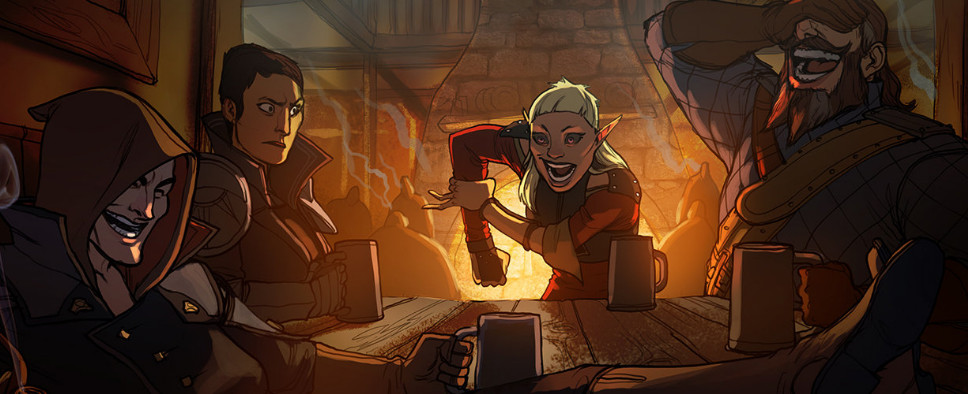The Changing Lore of Dragon Age
-
Category: News ArchiveHits: 4175

This PCGamesN article argues that retconning established canon in RPGs may not be just a cheap move by hack writers who write themselves into a corner, but instead something that can enrich the game's lore and make it feel more real. They use Dragon Age and its world as an example, praising the series for its unreliable narrators and comparing Dragon Age's lore to historical texts that gradually change over multiple retellings. And while I still disagree with the general premise, the article does raise a few good points. Check it out:
We are often spoilt when it comes to explaining why things are the way they are in a game world. Codices, wikis, clumsy environmental storytelling; we are given a range of resources in order to understand the virtual world in which we roam. A game’s lore inspires fans to dedicate hours to writing explanations or debating the tiniest details online, figuring out how it all pieces together. When we think of a game world’s history we think of it as a single narrative, a collection of events and characters, with little room for new branches once a sequence has been established.
But history is not an unchanging tome of information. History is constantly privy to the shifting perspectives of society, our unreliable memory, and new pieces of information suddenly shedding fresh light on a situation. For example the ancient city of Troy was widely assumed to not have existed until the excavations by Heinrich Schliemann in the late 19th century proved otherwise. It is a difficult thing to get across in a game, especially in a time when information is readily available at our fingertips - we are used to making queries in a search bar and getting a solid(ish) answer back immediately. Fan-made wikis and arguments over whether something is ‘canon’ only complicate matters. But whether intentional or not, BioWare have managed to work against this friction to create a fascinating example of historiography in Dragon Age, confidently changing its lore over different games in the RPG series, even daring to go against whatever one might consider canon in its games.
Warning: Dragon Age Inquisition spoilers follow.
Dragon Age: Inquisition, the third game in the series, makes numerous revelations in regards to the history of its fantasy world. One of the most interesting examples is found in the facial tattoos that certain groups of elves in the games mark themselves with. We are told in the codex and by characters, in both the first and second games, that the Vallaslin - as the tattoos are known - are the outcome of a religious ritual stemming from ancient elven culture, and that the different designs represent various deities in the Elven Pantheon.
However, in Inquisition, we are introduced to the character of Solas, an enigmatic elven mage, who throws a spanner in the works. It turns out that Solas is actually from those ancient times. If the protagonist is an elf and romances him in Inquisition he gives you the option to remove their Vallaslin, as he reveals that these tattoos were not originally done as a show of faith, but were actually slave markings and a sign of ownership.
This twist could be read merely as a way to shock, but it has a more subtle effect on our relationship with the game’s history and the reliability of memory within it. The protagonist, upon hearing this information, can disavow the markings, suddenly going against the consensus of their culture. Or the character can keep the tattoo, acknowledging that whatever the original meaning, it no longer matters, as the unity it represents in their modern culture has replaced it. By changing or adding to the lore here, the writers have not undermined the world they have built, they have enriched it. We feel the subtle impact not just on a character’s personal decision, but what it might mean for the society as a whole, and how it processes the tragedies and prejudices of the past.
One of the reasons that this change in lore makes Dragon Age’s own history feel real, and not flimsy, is that the information provided to you throughout the series has always been potentially unreliable. The series gives us named sources, therefore making everything in the codex at risk of fallibility and at the mercy of that person’s motives, emotions, and memory. Sources range from oral histories, papers written by scholars of the church and universities, personal journals and letters, popular histories told by bards, and descriptions of material culture and architecture.
Where a piece of historical information is sourced from within the codex has a huge impact on whether it can be trusted or not. Compare this to a piece of information that is presented to us in the codex section of a game menu as a block of text, with no name or source attached to it - we are led to assume that this knowledge comes from an omniscient writer adding to what is already in the game. BioWare themselves present information like this in Mass Effect: Andromeda. Perhaps our natural assumption is that the information comes directly from the game’s actual developer or writer, rather than a character from within the game. When a game’s lore is presented in this way, we tend to leave it unquestioned, as if it were an axiom of that world.
It is different in Dragon Age. Knowledge feels like it has been passed down through the ages, knocking against different cultures along the way, rather than simply being the product of a writing room. As well as seeing information being disseminated differently in the codex, we also see it within the world itself.[...]

